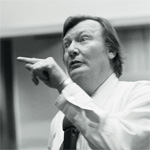A marvellous adventure
Carlo Rubbia’s name is closely related to the discovery of the W and Z particles at CERN. In 1984, he was awarded the Nobel Prize in Physics, together with Simon van der Meer, for the work he had done as head of the UA1 collaboration. During his mandate as Director-General of CERN from 1989 to 1993, the Large Electron Proton collider was inaugurated and the four LEP experiments gave their first results.
 “I came for the first time to live at CERN early in 1960. Today, over 45 years later, I feel as motivated and enthusiastic for institutionalized international cooperation as I was on the first day, at the time when such an innovative concept, so popular nowadays, was essentially unknown.
CERN was born by a remarkable group of founding fathers, at the threshold of a renewed European prosperity, to promote pure science on a global European scale and to create trust and unity between people of different countries, traditions and mentalities, after the disasters of the Second World War.
“I came for the first time to live at CERN early in 1960. Today, over 45 years later, I feel as motivated and enthusiastic for institutionalized international cooperation as I was on the first day, at the time when such an innovative concept, so popular nowadays, was essentially unknown.
CERN was born by a remarkable group of founding fathers, at the threshold of a renewed European prosperity, to promote pure science on a global European scale and to create trust and unity between people of different countries, traditions and mentalities, after the disasters of the Second World War.
CERN has been for us an extraordinary ‘melting pot’, gathering a large number of remarkable and very young talents from many different countries. Living together— so to say ‘under the same roof’ — and with a satisfactory adequacy of resources, we have been able to operate in a unique climate of absolute scientific freedom with an immense enthusiasm and motivation. We all have enjoyed a ‘sum-plus’, in which the resultant combination of the team has been far more relevant than the sum of the separate contributions of each of us.
The originality of the CERN accelerator community has been evident from the beginning, with the realization of the first strong-focusing proton accelerator by John Adams, then in his thirties, and by the remarkable team he had built up. He had the courage of cancelling the already approved 10 GeV weak focusing for a totally innovative 25 GeV Proton Synchrotron. The next adventure was the realization of the Intersecting Storage Rings, the ISR, which acted as a ‘reference’ for all the subsequent projects, and which was made possible by the vision of the then Director-General, Viki Weisskopf.
However, the physics results, mostly because of non-optimal choices in the instrumentation at those times, were probably, in retrospect, below what they should have been. But the many accelerator innovations, learned with the ISR, allowed features for the SPS that were far more advanced than the ones at Fermilab in the United States, a relatively conventional accelerator, thus making possible a subsequent fast conversion into the SPS collider. An excellent accelerator, the SPS already had all the basic features to become a collider. In order to do so, an industrial antiproton source was necessary, at a time when even a handful of antiprotons was considered a success. This required overcoming the so-called Liouville theorem, amplifying early studies performed at the ISR by Wolfgang Schnell and Simon van der Meer. Enthusiasm and drive were so high that this jewel, the Antiproton Accumulator was built in less than two years!
The marvellous chain of new accelerators, SPS first and LEP later, have been complemented by the development at CERN of a number of equally revolutionary instrumentation technologies, such as the wire and drift chambers, the calorimeter (Herwig Schopper), and so on, without which all important discoveries in the field world-wide would have been impossible and for which Georges Charpak well deserved his Nobel Prize.
The discovery of the W and the Z, promptly recognized by the Nobel Committee, was then so to speak ‘the tip of the iceberg’ of a marvellous and unique adventure in which so many remarkable people from so many different countries, several of whom unfortunately no longer with us, have proudly contributed.
In order to assess the importance of what has been accomplished by the CERN teams in those days, it is sufficient to point out that for a quarter of a century — presumably until the LHC will take over — the world’s hadronic high energy frontier has been dominated by two proton–antiproton colliders, the first entirely developed at CERN and the second incremented in energy with the Tevatron at Fermilab.
We have tremendously enjoyed this ‘Belle’ epoch of CERN: we are proud of what we have been able to accomplish.
The time has come for a generation change and a new CERN is now in place. To quote Simon van der Meer: ‘If they have some idea — however crazy it is — they should check up on it. Once in a hundred times it will turn out to be a good idea.’ ”
From the book Infinitely CERN: memories from fifty years of research +++

